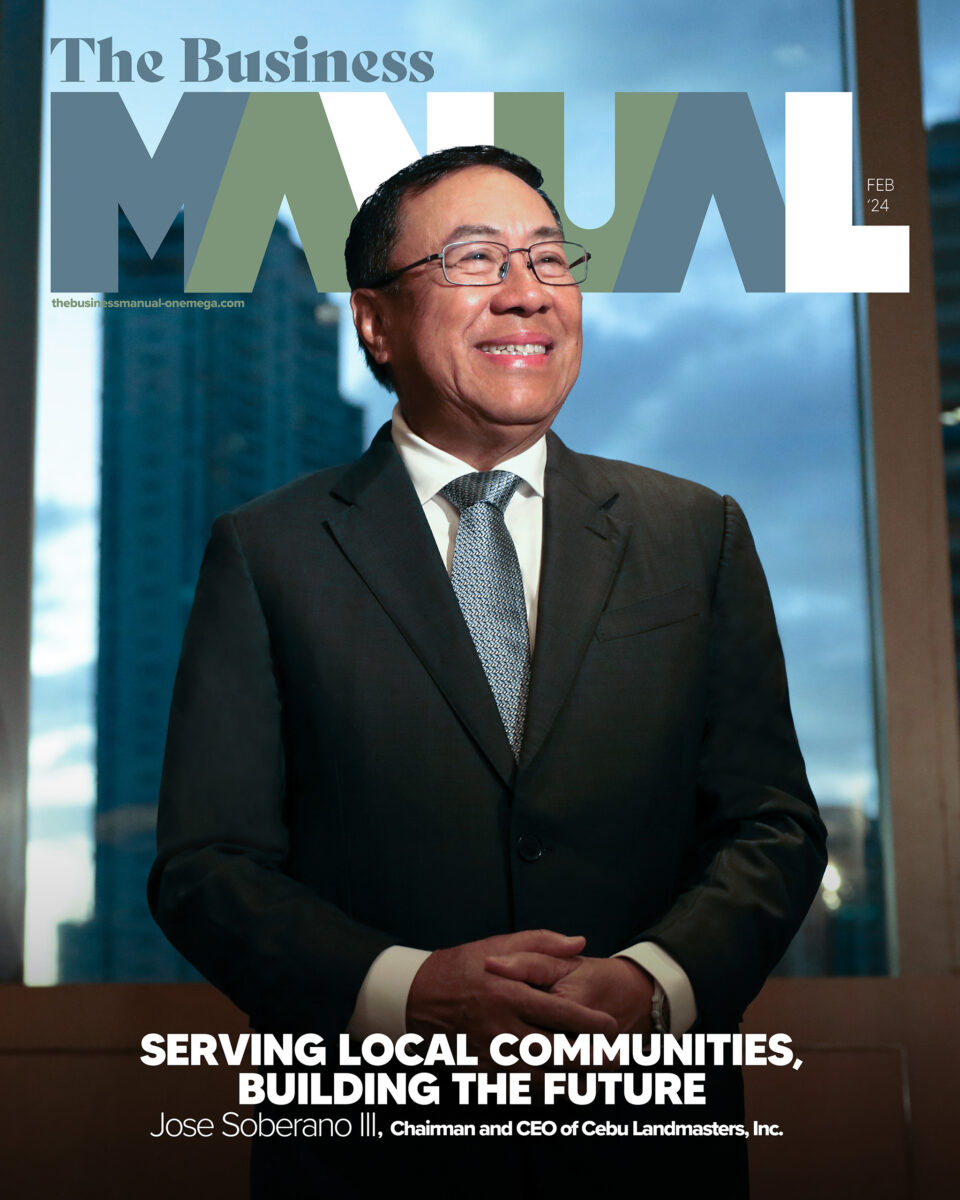Meet Bryan Yap: Philanthropist and Pioneering Leader of Lepanto Mining
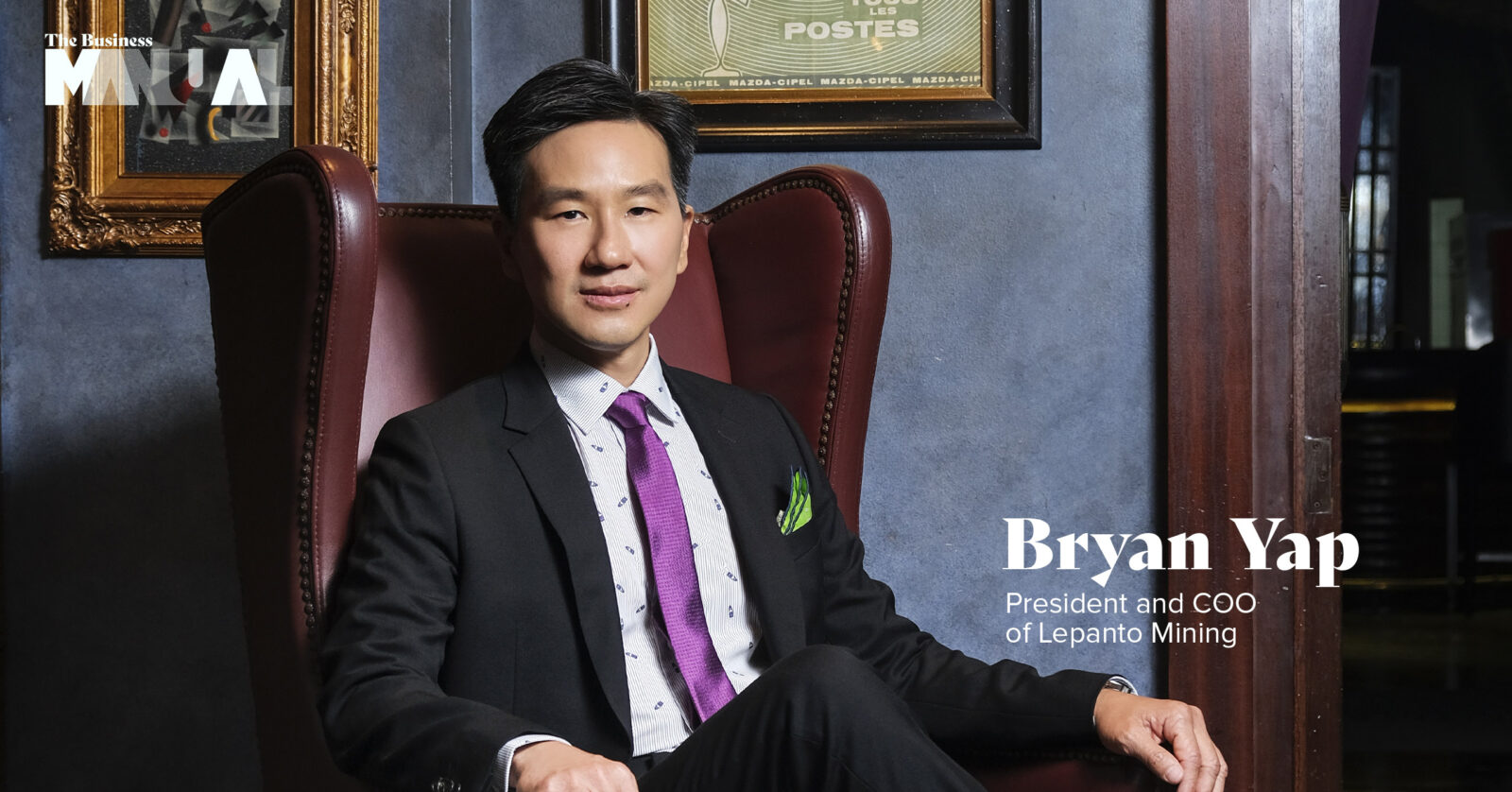
Under Bryan Yap’s leadership, Lepanto Mining has struck gold in Mankayan. Since then, he devoted his cause to innovating and giving back to the community.
Mining was not a top-of-mind choice for Bryan Yap back then, but as they say, “fate finds a way.” A graduate of the University of British Columbia with a course in Economics, he first joined a stock brokerage firm for about a year before joining the Lepanto Group of Companies (Lepanto) in 1994.
And so, he found his way into the mines.
Initially, Bryan started as the Vice President for Manila Mining—an affiliate company of Lepanto. Soon after, he became the Chief Finance Officer of Lepanto Consolidated before becoming the President. All the while, he moved from his comfort zone in finance to operations, where he began to explore the specialized nature of this industry, and eventually, visited the mine itself.
Fast forward to the present, he now serves as the President and Chief Operating Officer at Lepanto. From his position, the vantage point is clear: he can now change lives, help the country, and give back to the community.

Exploring the Lepanto Mines
Lepanto is a proudly Filipino underground mining company based in Mankayan, Benguet. Located high in the mountains of the Cordilleras, it is responsible for producing copper, gold, and silver for 85 years—dating as far back as the second world war.
“The mining industry is the most misunderstood industry,” Bryan explains in an online interview. “[Thus], it is our duty to educate the public of the good things mining can do for the community and our country. We are not destroyers of the environment. We are partners of government in community-building, oftentimes taking the lead.”
Last 2017, at the height of anti-mining campaigns, Bryan decided to open the Lepanto mines. With the goal of transparency and dispelling any misunderstandings, he brought in journalists, media personalities, influencers, and photographers to the site. That way, they can witness firsthand the extent of the mine’s operations.
“The public has a very limited understanding of what we do. What they know about mining is what they read in sensationalized reports. This is not reality. It is our responsibility to change their perception about mining,” he continues. “The mining industry has one of the widest footprints in terms of social responsibility. Whenever I bring guests to Lepanto Mine, the feedback I get is always a sense of awe in terms of the scale of the area and the operations.”
Additionally, Lepanto started a reforestation program decades ago. To date, they have planted over 7 million trees over an area of 1000 hectares. And with an ISO 14001 certification (an international standard for environmental management systems), it’s clear as day that Lepanto truly cares about the environment—contrary to what most say.
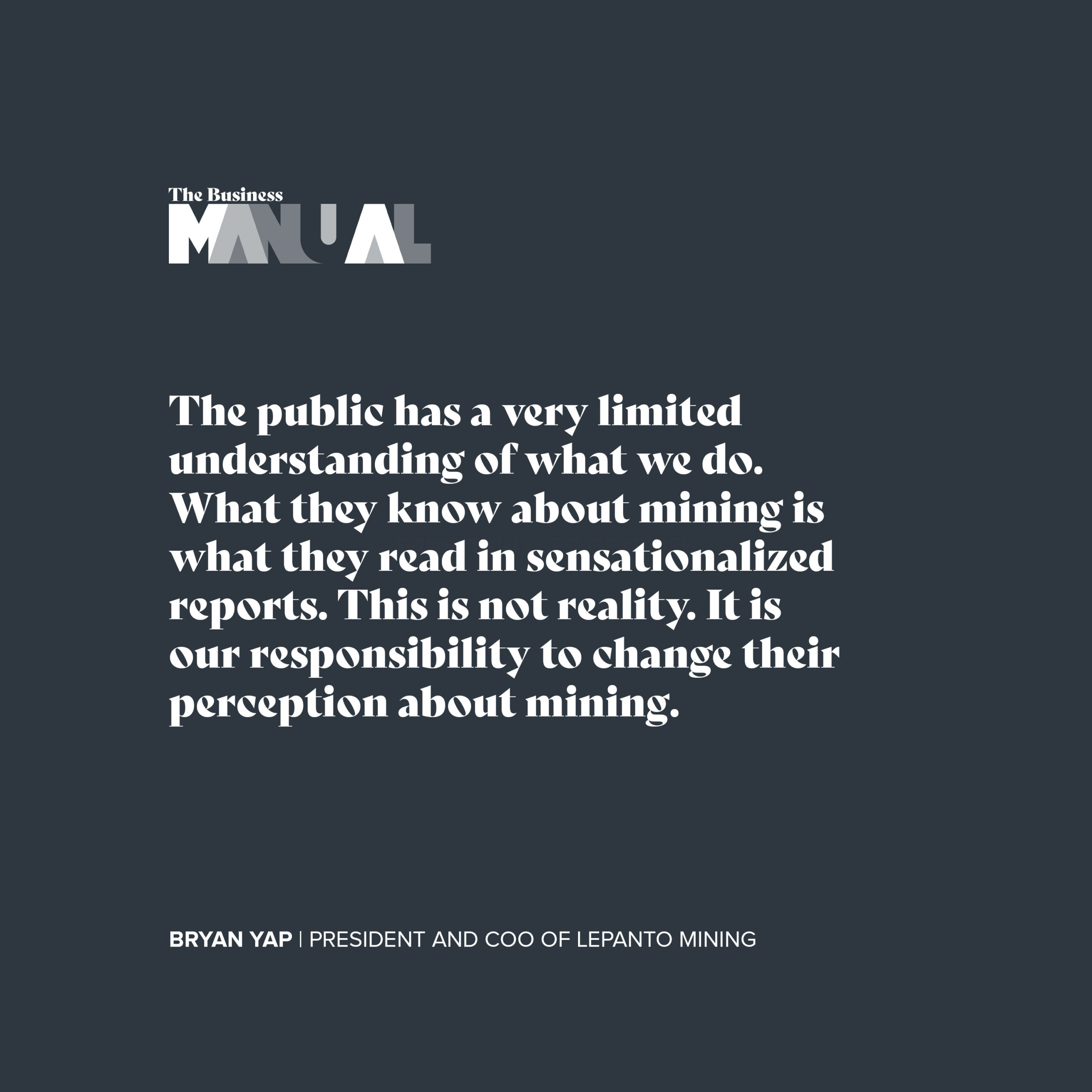
Responsible Mining, Explained
As part of good business practice and practicing social responsibility, Lepanto has established #LepantoCares—a cause dedicated to responsible mining and giving back. This, along with the practice of responsible mining, has been Lepanto’s guiding principle for the last 85 years.
But what is responsible mining? Bryan breaks it down into 4 categories: “A responsible mining company looks after the welfare of its employees; it operates in the highest standards of safety and health; it respects the rights, culture, and perspectives of host and neighboring communities—including indigenous communities—and works collaboratively with them; and it operates with the utmost respect for the environment.”
“We provide free medical, dental, and surgical services to our employees and their dependents,” he explains. “Lepanto supports at least 2,000 households or roughly 10,000 people. Housing units and utilities like water and electricity are provided free to mine employees.” And with a majority of the workforce comprising of third-generation employees, it’s clear how family ties run deep—both for Bryan’s family, his relatives, and the people he works with.
In fact, Grace Poe retells her mom Susan Roces’ experience in the Lepanto mines during the 2014 Philippine Mining Conference. In her speech, she shares, “My mom [who grew up in a mining district in Benguet] also said that the people of their mining community really cared and looked out for each other. May malasakit.”
“The people in their mining community did practically everything together, and this shared experience [perhaps] is the reason why the sense of solidarity was so strong in their community. I thought of sharing this story with you because this is how responsible mining ought to be conducted.”
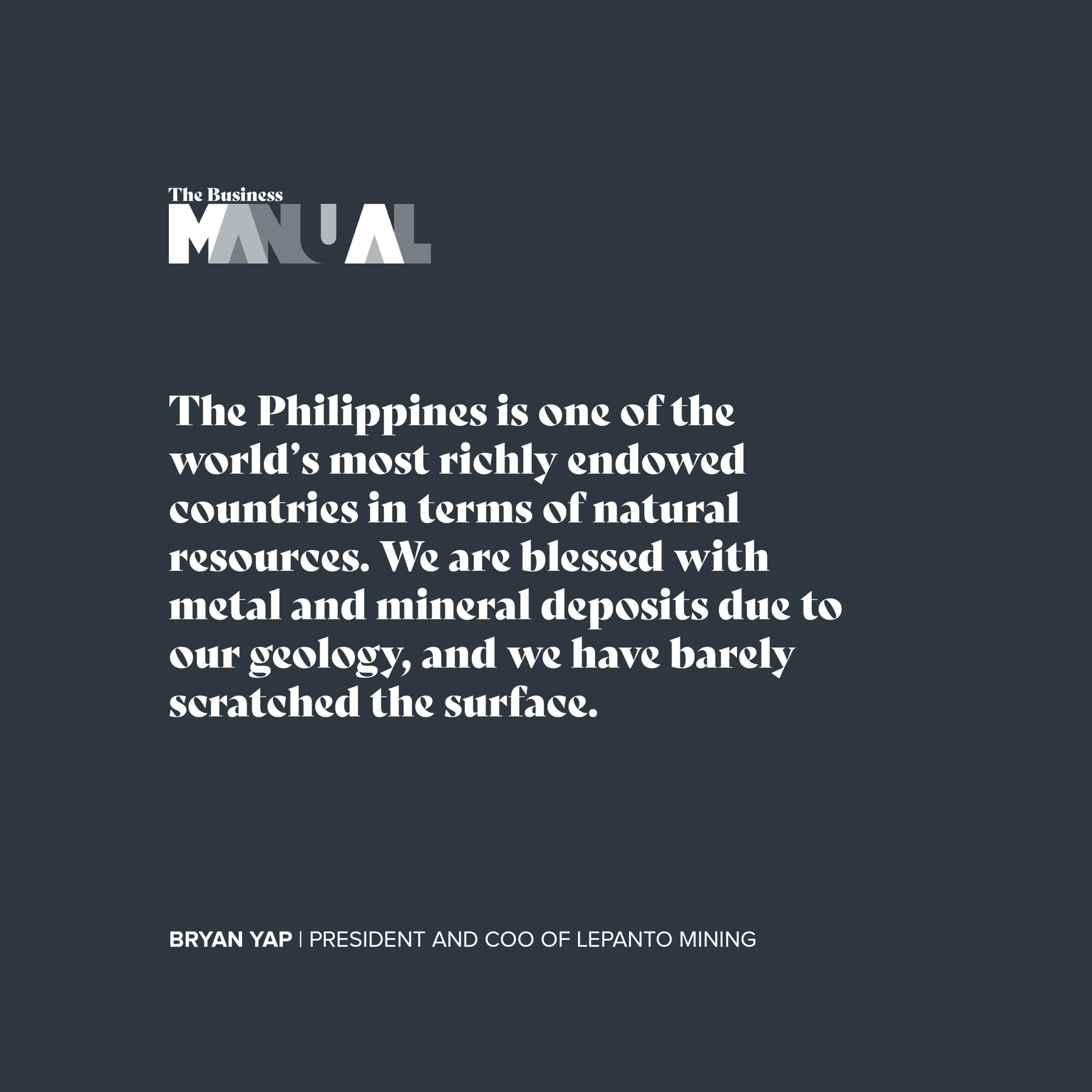
On Giving Back to the Community
Overall, the contributions by Lepanto Cares—whether to its employees, to the people, and to the environment—have helped Mankayan graduate into a first-class municipality.
Under the law, the mining industry is mandated to allocate 1.5% of its total cost and expenses to improving and enhancing the living standards of its host and neighboring communities. These include constructing infrastructures like roads, schools, hospitals, and bridges, among others. Beyond buildings, livelihood programs and educational scholarships are also welcomed.
Thus, Bryan has set his sights on the municipality of Mankayan, where their precious metals are ores come from. “Just within the area where Lepanto operates, we have 3 elementary schools with over 1,500 students, one national high school with over 1,000 students, a Catholic Church, two Iglesia ni Cristo churches, an Anglican church, a golf course, a community hall, a community library, a Philhealth accredited hospital, just to name a few,” Bryan shares.
“Lepanto has [also] constructed over 12 kilometers of farm-to-market roads. Our other infrastructure projects include construction of barangay and municipality buildings, school improvements, water system improvements, and many others,” he adds proudly. “The Lepanto Educational Assistance Program has produced over 700 graduates since 2002. In addition, Lepanto has produced 14 professional mining engineers and geologists since the inception of its full scholarship program in 2012.”
Lepanto Mining, Then and Now
Managing a large industry like Lepanto does not come easy. Not everyone can handle this tough business, but it takes good leadership, an effective team, and some luck to bring the company to success. Thankfully, Bryan has a good mix of all three.
“Mining is a long-term venture and extremely high-risk requiring a lot of capital, expertise, and luck,” he explains. “Before reaching production, a company can spend years and billions of dollars on exploration without finding a deposit that can be mined profitably. [But] if a deposit is determined to be feasible for mining, the development will take a minimum of 5 years, barring any political and regulatory challenges.”
“The Philippines is one of the world’s most richly endowed countries in terms of natural resources,” he continues. “We are blessed with metal and mineral deposits due to our geology, and we have barely scratched the surface. Lepanto is very lucky that we are located in a highly mineralized district—we have been mining here for 85 years and we still have more resources to mine in the future.”
Just like a lot of businesses in the country, Lepanto struggled to stay afloat amid the pandemic. Since the company mainly exports its goods, it operated under stringent conditions. Struggling with manpower mobility, shortage of essential supplies, transport, and other logistical problems are just some of the many problems that Bryan shares. Nevertheless, the evolving regulations and norms have helped them survive even until today.
Although most companies focus on the present, Bryan envisions a bright future for Lepanto. That is, by constantly evolving and innovating. “We are always looking for ways to improve our mining operations, making them more efficient and cost-effective. There are a lot of new mining technologies available in the market to accomplish this.”
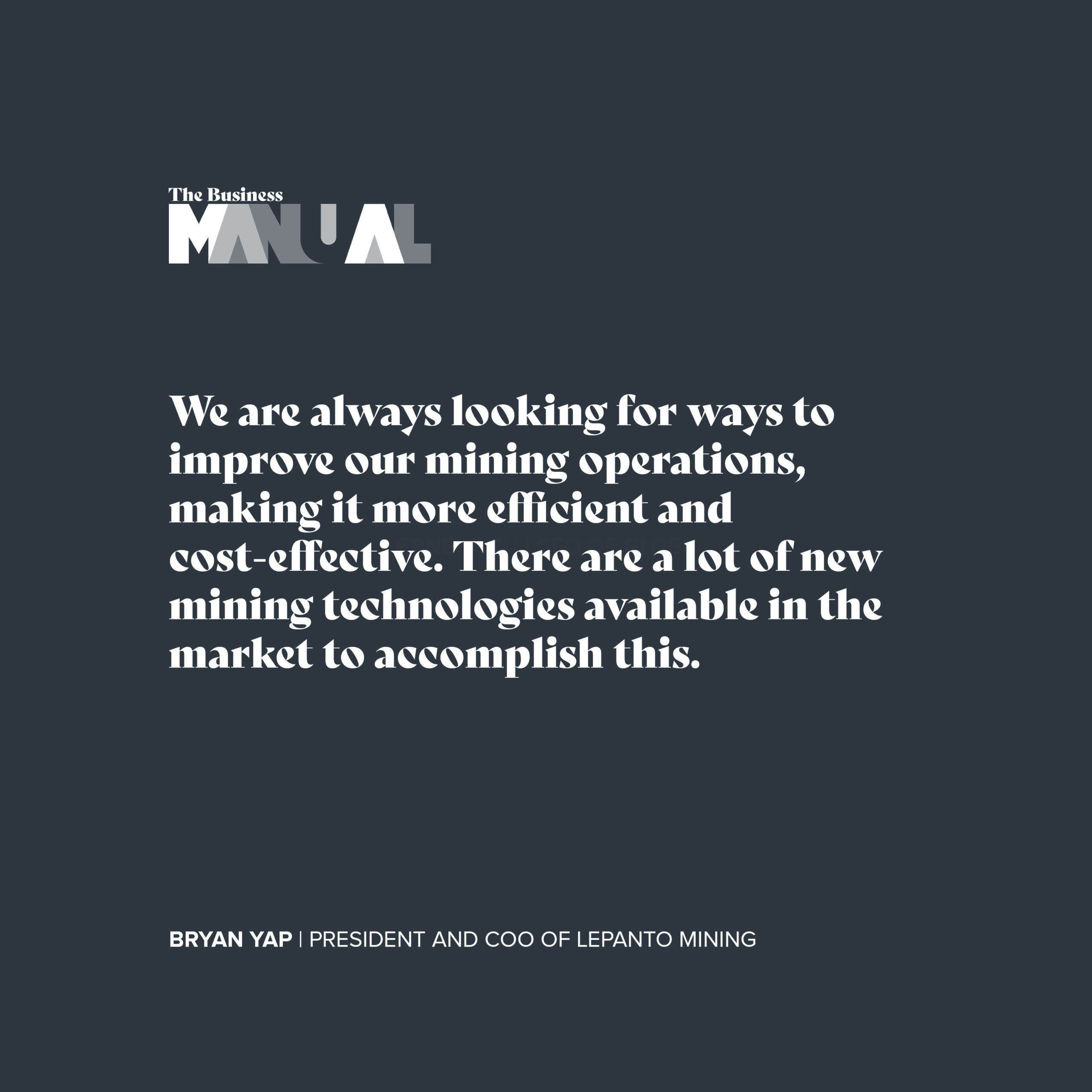
Exploring the Best of Mankayan
Off work, most take the time to rest and recharge. But in Bryan’s case, he remains as busy as ever. Since March this year, he has been spending more time in Mankayan—immersing himself in the local community, visiting the surrounding barangays, and seeing the best of what this place has to offer.
“In my opinion, Mankayan is one of the most beautiful and untouched places in the Philippines,” he shares. “In my own way, I am trying to help our local government to promote Mankayan as a destination for travelers and explorers. Mankayan has everything! If you’re looking for rivers, lakes, or waterfalls, the question to ask is ‘how many do you want to see?'”
“Mankayan [also] has sprawling rice paddies so you don’t need to go all the way to Ifugao to find them. Breathtaking sceneries of the Cordilleran mountains, we have it here. The beauty of the experience is having a local, perhaps a farmer or an elder, bring you to these places and see them in their natural state the way locals enjoy them. [Hearing] the stories of these farmers’ struggles and triumphs is [also] part of the experience.”
To highlight his travels and promote the underrated beauty of Mankayan, Bryan has documented his adventure in the hashtag #BiyaheNiB. Soon after, it evolved into #BiyaheNiB Gives Back when visits to remote and far-flung areas were soon interwoven into his stories.

#BiyaheNiB Gives Back
When asked about his most rewarding experience, Bryan shares the time he visited Cabiten, one of the most remote places in Mankayan last July. It was physically taxing, with a 1.5-hour drive, and more than 2 hours of walking up and down steep mountain ranges. The goal? To give children some much-needed school supplies and groceries.
“When we got to the school, we saw beautiful faces of smiling children who were just so happy to see us. We had so much fun playing with the kids and the joy on their faces when they saw the books, candies and chocolates were very moving. When we were about to leave, they didn’t want us to go and wanted to bring us to a nearby waterfall to play some more. We couldn’t resist the invitation so we swam with the kids and played some more. Where else can you experience something like that?”
Following that incident, friends and relatives have followed suit—donating more canned goods and school supplies for the next #BiyaheNiB Gives Back. With a team of roughly 10 people from different walks of life, Bryan credits the success of this project to these capable members.
And if anything, the accomplishments of both Bryan and Lepanto Mining for the municipality of Mankayan are a true testament that mining, eco-tourism, and agriculture can co-exist harmoniously.
Words DIANE NICOLE GO
Photography ED SIMON
Art Direction FERDI SALVADOR
Grooming ANGEL MANHILOT for NARS PH
Sittings Editor MARGA MEDRANO TUPAZ
Shot on Location at THE PENINSULA MANILA
RELATED ARTICLES:
A Man of Many Hats: Robert Gerard Nazal Jr. on Building a Better World
Business of Beauty: How Local Brand Colourette Secured Seed Funding
